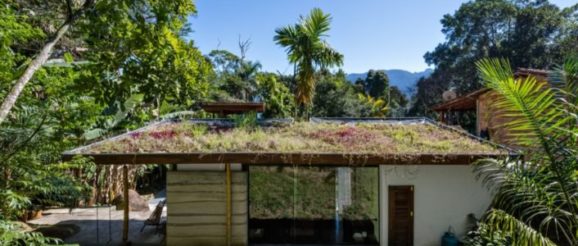Eco-friendly guesthouse sports a green roof and rammed earth walls | Inhabitat – Green Design, Innovation, Architecture, Green Building

In continuation of its work on the eco-conscious Camburi community center, Sao Paulo-based architecture firm CRU! architects recently completed the Guesthouse Paraty, a sustainable social building project that provided construction jobs and training to the local community. To minimize the environmental impact of the building, the architects used natural materials sourced locally, from red earth excavated on site to the tree trunks and bamboo cut from the surrounding forest. The guesthouse was also built to follow passive solar principles to keep naturally cool in Brazil’s tropical climate.
Designed with flexible usage in mind, the nearly 37-square-meter Guesthouse Paraty can be used as short-term lodging, a workspace or a play space for children. The compact, single-story building includes three beds — the bedroom consists of a double bed and a lofted single bed, while a convertible futon sofa is located in the living area. The open-plan living space also includes a small cooking area and dining table. To keep the guesthouse from feeling cramped, the architects installed expansive walls of glass that usher in daylight and frame views of the outdoors; the glazed entrance on one end of the building also opens up to a sheltered outdoor living space.
Because the project location is far from the town center, the architects wanted to use materials sourced from the site. As a result, the building was constructed with rammed earth walls and topped with a green roof finished with locally sourced black earth and plant matter. The formwork used for the rammed earth walls was recycled to build the roof structure. The columns supporting the weight of the roof were built from bamboo. Further tying the building in with the site is the inclusion of the existing massive granite rock that now forms part of the bedroom wall.
The overhanging roof eaves and the green roof mitigate unwanted solar heat gain. All windows are operable and strategically positioned to optimize cross-ventilation. Insect screens were installed to protect against mosquitoes.
